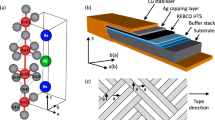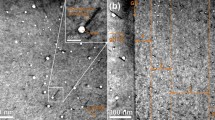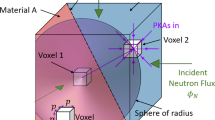Abstract
I HAVE reported the fine structure of the isothermal annealing curves of neutron irradiated solid compounds in a series of publications1–9. The structure was confirmed later by others10–12. An oscillating structure was always found for the isotherms, irrespective of the chemical constitution of the lattice and the nuclear events which produced the recoil radionuclides. The phenomenon thus seems to be based on some general property of a radiation damaged lattice. I now describe similar annealing behaviour for radiation damage detected physically, using the neutron diffraction method with irradiated single crystals of compounds similar to those studied already by radiochemical means. Tri-ethylenediamine, cobalt nitrate and chloride in the form of single crystals were reactor irradiated for 1 h in a position where the neutron thermal and fast flux were 4.18 × 1012 and 2.6 × 1011 neutrons cm−2 s−1 respectively. The absorbed gamma dose was about 30 Mrads. After irradiation the single crystal was oriented to give an intense diffracted neutron beam at the MAN neutron spectrometer of the 1 MW nuclear reactor. The diffraction spectrum for a particular lattice plane was taken before and after reactor irradiation. The maximum was shifted about 0.15 of a degree and the new peak was used to examine the variation in the intensity; the shape of the peak did not change during annealing.
This is a preview of subscription content, access via your institution
Access options
Subscribe to this journal
Receive 51 print issues and online access
$199.00 per year
only $3.90 per issue
Buy this article
- Purchase on Springer Link
- Instant access to full article PDF
Prices may be subject to local taxes which are calculated during checkout
Similar content being viewed by others
References
Dimotakis, P. N., and Kontis, S. S., Radiochim. Acta, 2, 85 (1963).
Dimotakis, P. N., thesis (Cambridge University, 1964).
Dimotakis, P. N., and Maddock, A. G., J. Inorg. Nucl. Chem., 26, 1503 (1964).
Dimotakis, P. N., and Stamouli, M. I., J. Inorg. Nucl. Chem., 26, 2045 (1964).
Demetroulas, C. P., and Dimotakis, P. N., J. Inorg. Nucl. Chem., 28, 2756 (1966).
Dimotakis, P. N., and Stamouli, M. I., Z. Phys. Chem., 55, 197 (1967).
Dimotakis, P. N., J. Inorg. Nucl. Chem., 30, 29 (1968).
Dimotakis, P. N., Maddock, A. G., and Vassos, B., Radiochim. Acta, 8, 38 (1967).
Dimotakis, P., and Papadopoulos, B., J. Inorg. Nucl. Chem. (in the press).
Andersen, T., Lundager Madsen, H. E., and Olesen, K., Trans. Farad. Soc., 62, Part 9, 2409 (1966).
Costea, T., Negoescu, I., Vasudev, P., and Wiles, R., Canad. J. Chem., 44, 885 (1966).
Kronrad, L., and Kacena, V., Radiochim. Acta, 6, 181 (1966).
Baumgärtner, F., and Randl, R. P., Proc. Fourth Intern. Conf. on Hot Atom Chemistry, Kyoto (1967).
Author information
Authors and Affiliations
Rights and permissions
About this article
Cite this article
DIMOTAKIS, P. Oscillating Structure of Thermal Annealing of Radiation Damage revealed by Neutron Diffraction. Nature 224, 1198–1199 (1969). https://doi.org/10.1038/2241198a0
Received:
Issue Date:
DOI: https://doi.org/10.1038/2241198a0
This article is cited by
-
Monotonic transfer annealing kinetics associated with an oscillatory phenomenon in51Cr(III)-doped potassium chromate
Journal of Radioanalytical and Nuclear Chemistry Articles (1990)
-
Oscillatory annealing behaviour of three neutron-irradiated crystalline cobalt(III) complexes
Journal of Radioanalytical and Nuclear Chemistry Articles (1989)
-
Oscillatory transfer annealing in radiodoped chemical compounds
Journal of Radioanalytical and Nuclear Chemistry Letters (1986)
-
Exploration for longer periods in the oscillatory annealing phenomenon in neutron irradiated crystalline cobaltic compounds
Journal of Radioanalytical and Nuclear Chemistry Letters (1986)
Comments
By submitting a comment you agree to abide by our Terms and Community Guidelines. If you find something abusive or that does not comply with our terms or guidelines please flag it as inappropriate.



